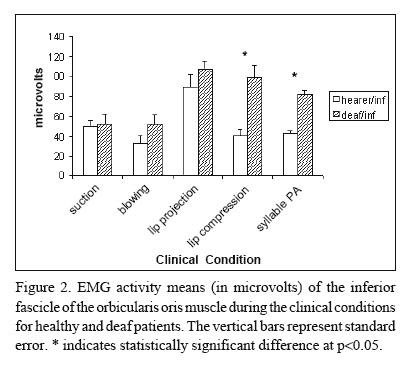Electromyography has been used to evaluate the performance of the peribuccal musculature in mastication, swallowing and speech, and is an important tool for analysis of physiopathological changes affecting this musculature. Many investigations have been conducted in patients with auditory and speech deficiencies, but none has evaluated the musculature responsible for the speech. This study compared the electromyographic measurements of the superior and inferior fascicles of the orbicularis oris muscle in patients with profound bilateral neurosensorial hearing deficiency (deafness) and healthy volunteers. Electromyographic analysis was performed on recordings from 20 volunteers (mean age of 18.5 years) matched for gender and age. Subjects were assigned to two groups, as follows: a group formed by 10 individuals with profound bilateral neurosensorial hearing deficiency (deaf individuals) and a second group formed by 10 healthy individuals (hearers). Five clinical conditions were evaluated: suction, blowing, lip projection and compression, and production of the syllable "Pa". It was found that the deaf patients presented muscle hyperactivity in all clinical conditions, and that the inferior fascicle of the orbicularis oris muscle showed higher electromyographic activity rates, suggesting the need for a hearing-speech treatment with emphasis on oral motricity.
electromyography; deafness; orbicularis oris muscle




